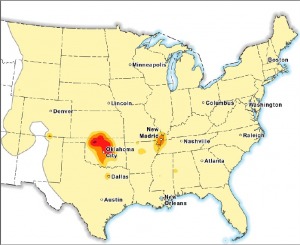Operating wind farm investors were concerned after reading conclusions of the U.S. Geological Survey (USGS) report entitled “One-Year Seismic Hazard Forecast for the Central and Eastern States from Induced and Natural Earthquakes.”
According to the report, Oklahoma, Kansas and northern Texas were the regions where the highest expected damage was forecasted. Earthquakes, which result from seismic activity, have the potential to cause damage to infrastructure, buildings and wind turbines. DNV GL reviewed the report, as well as design basis and calculations for many of the operating wind power plants in the Central and Eastern states. Our conclusion is this: Most should be capable of withstanding the higher frequency of earthquakes.
There has been a marked increase in the number of earthquakes in the Central and Eastern U.S. over the past few years. The average annual number of earthquakes of magnitude 3 or larger on the Richter scale between 1973 and 2008 was 21, and it was 99 between 2009 and 2013.
In 2014, there were 659 earthquakes of magnitude 3 or higher, according to the USGS.
The USGS has determined that there is a strong statistical correlation between increased use of deep wastewater disposal wells, used by the oil and gas industry, and the increase in induced earthquakes. The fluids generated during the drilling or fracking process is typically disposed of by the operators in wells at depths of 4,000 to 8,000 feet below the ground surface. The process of disposing the liquids in the wells, as a result of the hydraulic fracturing, is causing the earthquakes. Hydraulic fracturing injects a much smaller volume of fluid at a shallower depth, typically around 1,000 to 2,000 feet, which is well above the zones that generate earthquakes.
Forecast Of Regions With Damage
Estimating damages from induced earthquakes is challenging because traditional models do not take human activity into consideration. USGS ran multiple models and undertook substantial analysis in arriving at its conclusions.

As shown here, in an extract of the USGS report, the chance of damage due to earthquakes in Oklahoma and Kansas was similar or higher than that of those occurring naturally in coastal California. The primary concern with induced seismicity is the effect on existing un-reinforced masonry buildings that were not designed with seismic standards in mind and are sensitive to the high frequencies generated by the shallow induced earthquakes.
Higher frequency is not expected to impact wind farm operations or turbine design costs.
Wind turbine foundations are designed purposely for each individual project site, taking into consideration the local geotechnical conditions, the seismic activity, the wind turbine and the wind loading conditions. In regions of low seismicity, such as those in the Central and Eastern states, the design of the foundation is controlled by the extreme wind loads on the turbine. In regions of high seismicity, such as some locations in California, the seismic loading is more often the critical factor driving the design of the turbine foundation.
Although the USGS forecasts damage from more frequent earthquakes in the region, the USGS expects the maximum magnitude of the earthquakes occurring in the Central and Eastern states to remain the same.
This is because the magnitude of earthquakes is controlled by the seismic framework of the region. DNV GL’s review of the design basis and calculations for many of the operating wind power plants in the Central and Eastern states indicates the following: Turbine foundations in this region are designed to handle a much higher seismic load than that expected from the modeling in the USGS report for 2016, particularly considering the design standards require the consideration of a much longer exposure period more closely matching the design life of the wind farm.
Even with a higher frequency of earthquakes, seeing as the magnitude of the earthquakes is not expected to increase, the seismic plus operational loads are still less than the extreme wind loads, and the extreme wind speeds will continue to control the design. Given the predicted ground motion presented in the USGS report, the seismic loading is expected to be well within the design envelope for wind turbines and foundations, and the operating turbines should be capable of withstanding the higher frequency of earthquakes.
The wind industry has been taking seismicity into consideration in the design of wind turbine foundations, and the higher frequency of earthquakes is not expected to have an impact on operations or on the design or cost of building wind turbine foundations.
Author’s note: Matthew Rogers is global head of practice in civil engineering at DNV GL. He can be reached at matthew.rogers@dnvgl.com.




Did anything happened to the turbines?
Oklahoma has always had earthquakes. It has also had cycles of drought and storms. The “They” you mention are the government backed windmill industry. Simple: they are exempt from liability. Earthquakes in Oklahoma is nothing new, just part of its long history. They happen on a longer cycle. There is ample evidence of entire rivers changing courses over a longer history. Homes or basements with sub-par standards well known to have issues. Wind Turbine have caused huge environmental issues. You will just have to deal with those issues on your own. The Wind Turbines vibration evidently have a correlation to… Read more »
EARTHQUAKES in OKLAHOMA
What are they doing to the plumbing in our homes?
What are doing to the structure of our homes?
Etc.